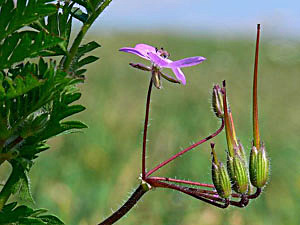
medicinal herbs
Stork's Bill
Erodium cicutarium

Herb: Stork's Bill
Latin name: Erodium cicutarium
Family: Geraniaceae (Geranium Family)
Medicinal use of Stork's Bill:
The whole plant is astringent and haemostatic. It has been used in the treatment of uterine and other bleeding. The root and leaves have been eaten by nursing mothers to increase the flow of milk. Externally, the plant has been used as a wash on animal bites, skin infections etc. A poultice of the chewed root has been applied to sores and rashes. A tea made from the leaves is diaphoretic and diuretic. An infusion has been used in the treatment of typhoid fever. The leaves are soaked in bath water for the treatment of rheumatism. The seeds contain vitamin K, a poultice of them is applied to gouty typhus.Description of the plant:

Plant:
Annual
Height:
60 cm(2 feet)

Flowering:
June toSeptember
Habitat of the herb:
Sandy dunes, grassland, arable land, waste areas, roadsides, railway embankments etc, usually near the sea.Edible parts of Stork's Bill:
Young leaves - raw or cooked as a potherb. Harvested in the spring before the plant flowers, they are tasty and nutritious. The leaves are added to salads, sandwiches, soups etc, they can be used in recipes that call for leaves of beet, plantain, sow thistle or amaranth. Young stems - raw. Root - chewed by children as a gum.Other uses of the herb:
A green dye is obtained from the whole plant. It does not require a mordant. The remnants of the styles are very hygroscopic, they can be used in hygrometers and as weather indicators. The dried plant powder has been mixed with watermelon seeds during storage and planting in order to prevent watermelon disease.Propagation of Stork's Bill:
Seed - sow in situ as soon as the seed is ripe in the late summer. The seed can also be sown in situ in late spring. Germination usually takes place within 3 weeks.Cultivation of the herb:
Sandy dunes, grassland, arable land, waste areas, roadsides, railway embankments etc, usually near the sea.Known hazards of Erodium cicutarium:
None knownPlant information taken from the Plants For A Future.
